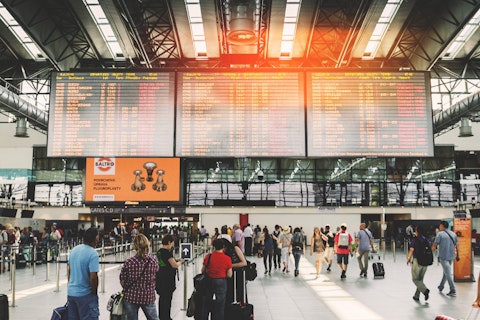This article will look at the 12 most profitable airports in the world while exploring their global trends, industry outlook, and key players. If you want to skip our detailed analysis, you can head straight to the 5 Most Profitable Airports in the World.
In today’s interconnected global economy, airports play a pivotal role in facilitating seamless travel and trade. These gateways to the world have evolved into multifaceted entities, catering to a wide array of services beyond mere transit hubs. From bustling terminals to state-of-the-art infrastructure and innovative revenue streams, airports have become crucial economic engines in their own right.
The Revenue Generation and Outlook
Airports generate revenue through a combination of aeronautical and non-aeronautical sources. Aeronautical revenue comes from charges imposed on airlines and aircraft operations, including landing fees, aircraft parking fees, passenger fees, and fuel sales—non-aeronautical revenue from terminal concessions, including retail shops, restaurants, and duty-free stores.
Car parking fees also contribute significantly to airport revenue, with charges based on the duration of parking and the type of vehicle. Moreover, airports earn from advertising and sponsorship agreements, rental income from commercial spaces, ground transportation fees, and revenue-sharing agreements with service providers. These diverse revenue streams allow airports to finance their operations, infrastructure development, and maintenance while providing essential services to passengers and airlines.
According to International Airport Review, as of March 2019, the global airport industry experienced a notable revenue increase of $172.2 billion. This growth, totaling 6.2%, indicates airports’ financial success and profitability worldwide.
As for 2023, the aviation industry has been prosperous and highly profitable overall. Despite rising fuel costs and global economic uncertainty, there is an overall consensus that air travel demand has remained strong. Airlines with optimized operating models and resilient balance sheets have adapted well to market challenges and maintained high demand.
For example, Copa Holdings SA (NYSE:CPA) Airlines expects a significant growth in passenger numbers, projecting an 11% increase. This can be attributed to the introduction of three new routes and the expansion of flight frequencies to various destinations. By the end of 2023, the airline aims to operate 328 daily flights and transport 16.1 million passengers, surpassing pre-pandemic levels.
On the other hand, airport operators play an equally significant role in the global industry of air transit. Fraport AG, with its extensive portfolio of 28 airports worldwide, and Heathrow Airport Holdings (formerly BAA Ltd.), operating six British airports and Naples Airport, exemplify this scale and influence of airport operators.
Concerning Airfares
Apart from the otherwise positive patterns in the industry, airfares have seen a significant increase recently, with a rise of nearly 43% from September 2021 to September 2022, according to the US Bureau of Labor Statistics’ Consumer Price Index. The price increase was predicted to vary depending on the origin and destination. GBC predicted a 2.0% rise in economy ticket prices from Europe to the Middle East, while travelers flying from Australia to Asia could expect a steep 24.9% increase in economy seat fares.
One key factor contributing to the rising airfares is the high demand outweighing the available supply. Increased leisure travel and reduced capacity due to labor shortages at airlines and airports have allowed carriers to raise fares and implement more restrictive inventory management strategies.
Another factor is the escalating cost of fuel, which is the largest operational expense for airlines, accounting for a significant portion of their expenditure. As of October 2022, jet fuel costs have surged by 64.7% compared to the previous year, reaching $155.77 per barrel.
Key Trends for Air Travel to Note In 2023
“Bleisure” travel, a combination of business and leisure travel, gained popularity during the pandemic when remote work became more prevalent. This trend is expected to continue in 2023 as passengers seek to explore new destinations and add vacation time to their business trips. Some airlines have responded by reconfiguring their cabins to offer more business-class seating and enhancing the overall travel experience for this segment of travelers.
For example, Delta Airlines Inc (NYSE:DAL) is set to revolutionize customer experience (CX) with its Delta Sync initiative. The airline plans to offer free Wi-Fi to all passengers, granting access to its personalization and loyalty program, Delta Sync. Partnering with brands like Paramount+ and New York Times, Delta Airlines Inc (NYSE:DAL) aims to provide personalized recommendations and rewards to enhance CX.
Moreover, Delta Airlines Inc (NYSE:DAL) equips its in-flight attendants with handheld devices and an application that provides real-time customer data and video chat capabilities. These developments aim to build trust, improve customer loyalty, and enable attendants to deliver exceptional experiences. For this reason, Delta Airlines Inc (NYSE:DAL) also appeared in our article on the Top 20 Most Profitable Airlines in the World.
Accessibility and inclusion will be a priority in 2023. Airlines and airports collaborate with disability groups to improve the travel experience for individuals with disabilities. Efforts include introducing autonomous wheelchairs and larger restrooms to accommodate mobility devices. This focus on inclusion is expected to continue to evolve throughout the year.
Amsterdam Airport Schiphol (AMS) conducted a one-week trial of autonomous wheelchairs that could replace or supplement staff passenger push services. The trial, in collaboration with Axxicom Airport Caddy, aimed to assess the viability of WHILL’s Autonomous Vehicles Service that is already in use at Japanese airports. The touch-panel-operated wheelchairs provide convenient transportation for passengers with reduced mobility, older adults, and those who require wheelchair assistance.
The power of data in the aviation industry must also not be neglected. Airlines, airports, and ground handlers leverage data to drive operational improvements. The Internet of Things (IoT) and AI-driven algorithms enable more efficient data management, enhancing resource planning and real-time decision-making.
Qatar Airways is partnering with Alphabet Inc (NASDAQ:GOOG) ‘s Cloud to leverage its data analytics, AI, and machine learning solutions to gain valuable insights from the vast amount of structured and unstructured data generated by the airline’s 18.5 million passengers across 150 destinations.
By utilizing Alphabet Inc (NASDAQ:GOOG) Cloud technologies, such as BigQuery and Vertex AI, Qatar Airways aims to unlock deeper meaning from customer data and enhance the travel experience. The collaboration will enable the airline to provide personalized offerings tailored to individual needs, travel trends, and past travel history, ultimately improving customer satisfaction.
In the aviation industry, airports and airlines often form strategic partnerships to optimize operations, improve the passenger experience, and achieve financial success. As primary users of airport facilities, airlines rely on airports to provide efficient services and infrastructure. On the other hand, airport management companies like Atlas Air Worldwide Holdings Inc (NASDAQ:AAWW) oversee airport operations, develop infrastructure, and attract new airlines and routes. This collaboration ensures smooth operations and may also facilitate the transport of essential aid during humanitarian crises.
For instance, Atlas Air Worldwide Holdings Inc (NASDAQ:AAWW) recently organized a humanitarian flight from Washington Dulles International Airport, delivering relief supplies via a Boeing 747-8F to assist earthquake victims in Turkey and Syria, showcasing its commitment to supporting global relief efforts.
Sustainability is another prominent theme for 2023. With the travel sector accounting for a significant portion of global carbon emissions, airlines and airports are actively taking steps to reduce their environmental impact. Initiatives include the introduction of sustainable aircraft, the developing of sustainable fuels, carbon capture projects, and green certifications.
This trend was notably observed by Atlas Air Worldwide Holdings (NASDAQ:AAWW) airlines that have tried to improve their fuel efficiency and reduce noise. In 2022, they integrated three new 747-8 and one new 777 aircraft. Also, they invested in hybrid and electric vehicles and equipment, with 13% of their vehicle fleet and 20% of their equipment being electric or hybrid. Two Green Globes certificates recognized their efforts for resource efficiency and environmental impact mitigation.
Methodology
To compile our list of the most profitable airports in the world, we used data from the Swedish firm WESTCOAST DIGITAL AB’s FlightsForum to highlight the airports with the highest number of flights per day. We’ve used this metric as proxy to gain insights on the most successful airports in the world.
Therefore, the greater the number of flights, the higher the profitability. This is because airports generate revenue through various sources, such as landing fees, terminal fees, and passenger charges. An increase in flights per day suggests a higher volume of aircraft operations, which directly translates to increased revenue opportunities for the airport.
More flights attract airlines, passengers, and businesses, increasing airport service and facility demand. Moreover, a higher frequency of flights indicates improved connectivity and accessibility, which can attract more airlines and stimulate passenger traffic.
Here is a list of the 12 most profitable airports in the world:
12. Shanghai Pudong International Airport (PVG)
Flights Per Day: 530
Shanghai Pudong International Airport (PVG) is a highly significant airport for its strategic location in Shanghai, one of the world’s largest economic and financial centers. As China’s primary international gateway, PVG is a crucial hub connecting Asia with the rest of the world. It is vital in facilitating global trade, attracting foreign investment, and promoting tourism.
PVG handles massive passenger and cargo traffic, offering extensive flight connections to numerous destinations. The airport’s importance is further accentuated by Shanghai’s status as a major manufacturing and business hub, making PVG a critical transportation hub for passengers and freight, promoting economic growth and global connectivity and making it one of the most profitable airports in the world.
11. Amsterdam Airport Schiphol (AMS)
Flights Per Day: 536
Amsterdam Airport Schiphol, or Schiphol Airport (AMS), is one of the most important airports in Europe and serves as the primary international gateway to the Netherlands. It holds significant importance due to its excellent connectivity to various global destinations. Schiphol Airport consistently ranks among the busiest airports in Europe in terms of passenger traffic and cargo volume. It is a major hub for numerous airlines and offers a wide range of flight connections worldwide. Schiphol’s efficient operations, modern facilities, and commitment to passenger experience contribute to its reputation as a key player in the global aviation industry. In the first half of 2022, Amsterdam Airport Schiphol saw a 120% rise in air traffic movements.
10. Delhi Airport (DEL)
Flights Per Day: 558
Delhi Airport, also known as Indira Gandhi International Airport (IGIA), is a vital transportation hub in India. It is a key connection point for domestic and international flights, facilitating travel to and from Delhi. With its multiple terminals and diverse amenities, the airport caters to the varied needs of passengers from around the world.
The airport is set to undergo a massive expansion, aiming to become the world’s largest airport. According to Jyotiraditya Scindia, India’s Minister of Civil Aviation, the ongoing development will propel IGIA to become one of the largest airports globally, surpassing Atlanta Airport in passenger capacity. It is already among the airports that generate the most profit.
9. Istanbul Airport (IST)
Flights Per Day: 577
Istanbul Airport is highly profitable because of its location at the intersection of Europe, Asia, and the Middle East, enabling it to cater to diverse travelers. With its state-of-the-art facilities and efficient operations, the airport can accommodate many passengers, driving revenue from various sources such as airline fees and concessions. The airport’s popularity as a tourist destination, along with Istanbul’s growing prominence as an economic and cultural hub, contributes to increased air traffic and commercial opportunities, ultimately enhancing its profitability.
Recently, the airport experienced a 12% increase in daily traffic as football fans departed after attending the 2023 Champions League Final held in Istanbul. According to Eurocontrol, Istanbul Airport recorded 1,684 flights on a single Sunday, surpassing Frankfurt Airport’s previous record of 1,624 flights set in 2019.
8. John F. Kennedy International Airport (JFK)
Flights per Day: 581
Situated near the New York City, JFK benefits from the high demand of travelers to and from one of the world’s most prominent metropolitan areas. It is a major transportation hub, offering a phenomenal range of domestic and international flight options. The airport’s extensive network of airlines, coupled with its modern infrastructure and facilities, attracts a large volume of passengers, leading to its increased revenue.
JFK was ranked as the most profitable airport in the US in 2015 based on its total operating revenue. It generated an operating income of $452,214,911, representing a 17% growth over five years. JFK showcased strong financial standing with an operating income per employee and per flight of $1,059,051 and $1,030, respectively.
7. Tokyo International Airport (HND)
Flights per Day: 613
Also known as Haneda Airport, it is one of the busiest airports in the world, serving as a major hub for domestic and international flights. The Airport has experienced significant growth in recent years, with a high volume of passenger traffic and airlines operating there. Its profitability can be attributed to its strategic location, efficient operations, extensive passenger amenities, and strong connectivity to major cities worldwide.
6. Los Angeles International Airport (LAX)
Flights per Day: 659
LAX is a sprawling aviation hub renowned for its size and importance. As one of the most profitable airports in the world, LAX features extensive facilities and serves as a vital link for domestic and international travel. With its diverse network of airlines and connections, LAX plays a crucial role in enabling worldwide travel and supporting the region’s tourism, business, and commercial endeavors.
The modern infrastructure and ongoing development projects like the terminal 4/5 modernization project demonstrate LAX’s dedication to providing millions of passengers with a seamless and enjoyable travel experience each year.
Click here to check the 5 Most Profitable Airports in the World.
Suggested Articles:
- 21 Biggest Airports in the World
- 20 Best Airlines in the World in 2023
- Top 20 Most Profitable Airlines in the World
Disclosure: None. 12 Most Profitable Airports in the World is originally published on Insider Monkey.





